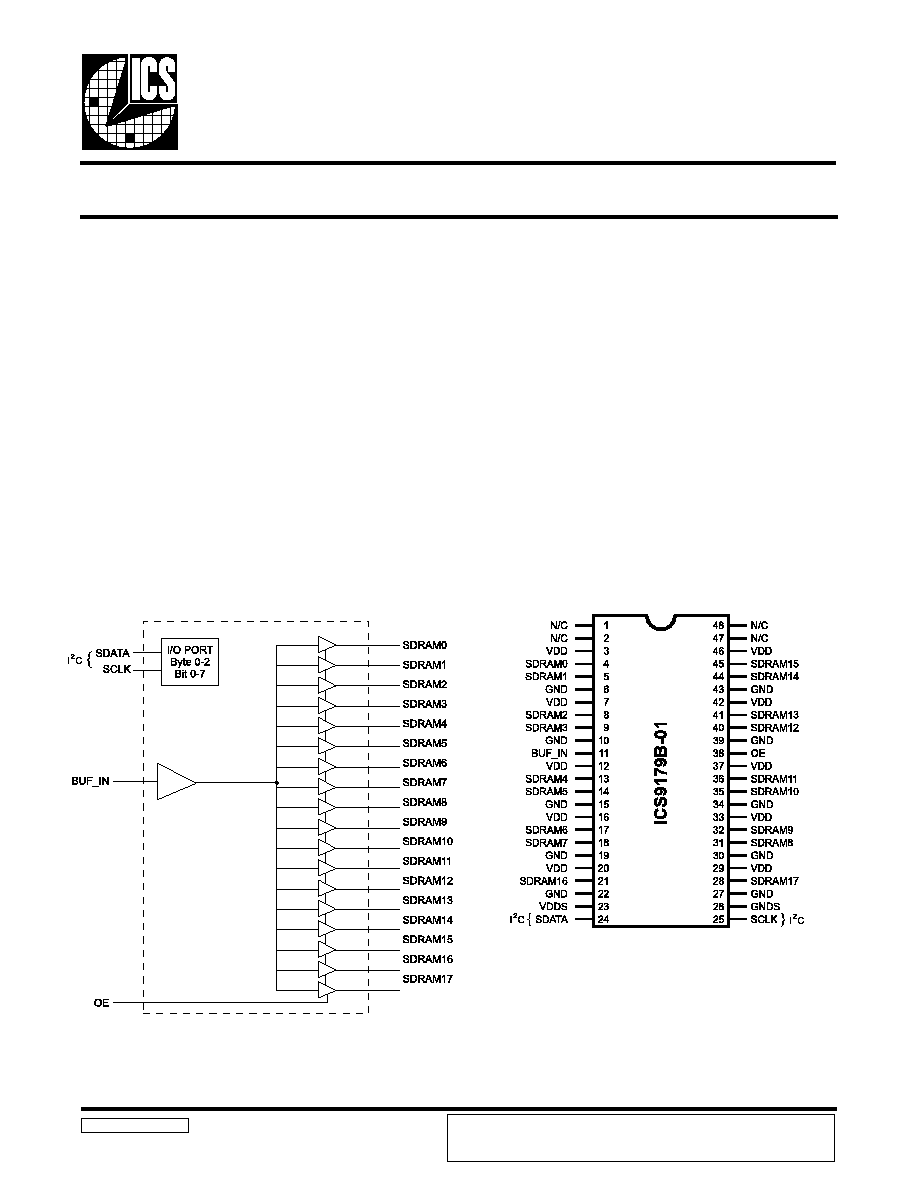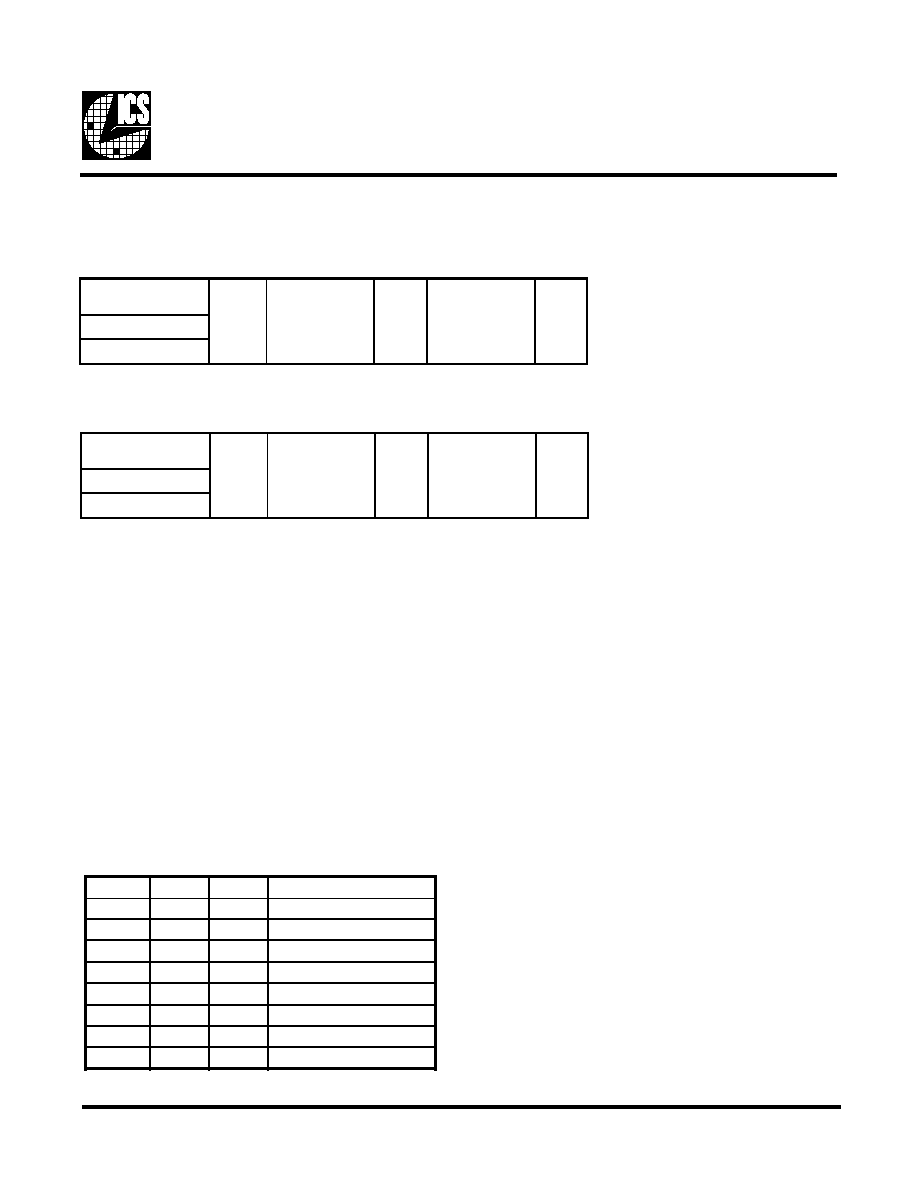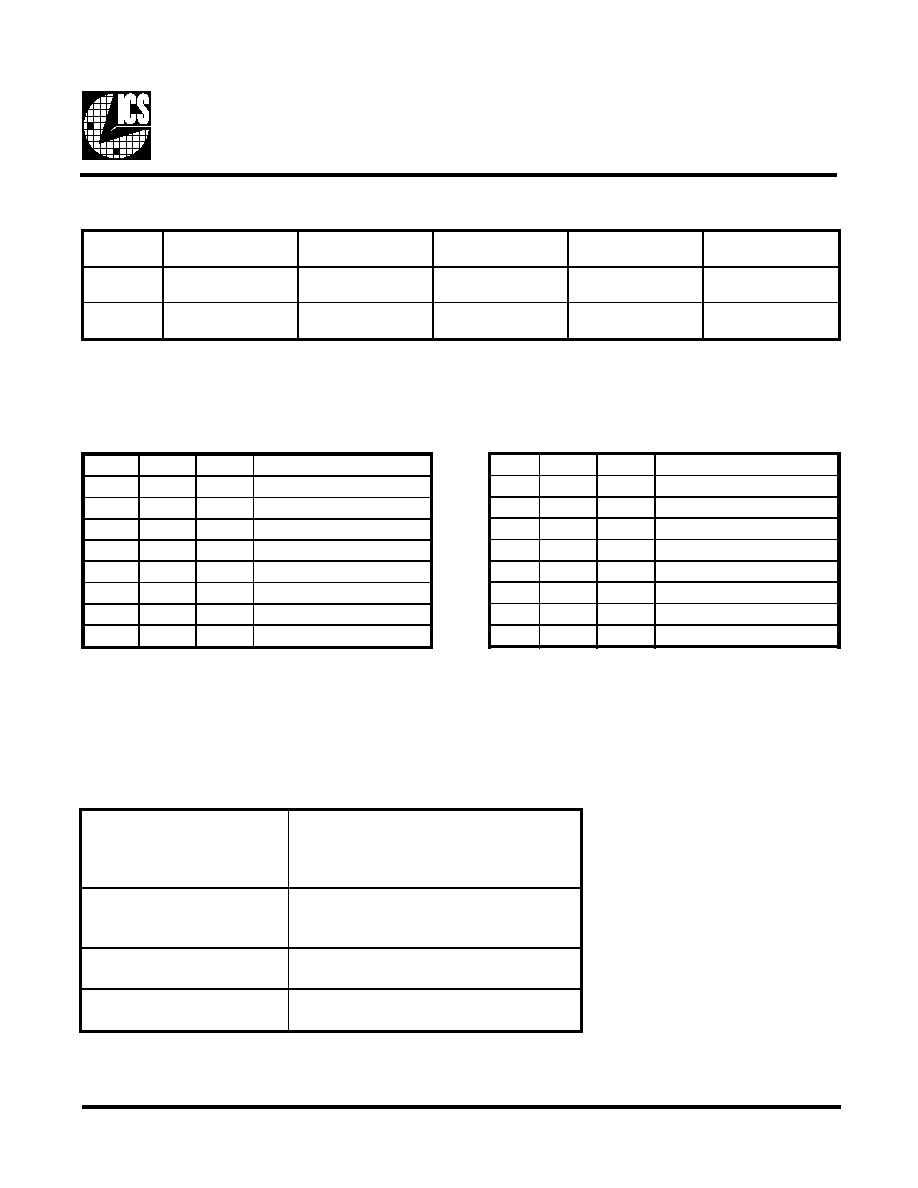/home/web/doc/html/icst/173735

Integrated
Circuit
Systems, Inc.
General Description
Features
ICS9179B-01
Block Diagram
PentiumPro is a trademark of Intel Corporation
I
2
C is a trademark of Philips Corporation
Low Skew Buffers
9179B-01 Rev C 05/18/98
Pin Configuration
The ICS9179B-01 generates SDRAM clock buffers required
for high speed RISC or CISC microprocessor systems such as
Intel PentiumPro or Pentium II. An output enable is provided
for testability.
The device is a buffer with low output to output skew. This is
a Fanout buffer device, not using an internal PLL. This buffer
can also be a feedback to an external PLL stage for phase
synchronization to a master clock.
The individual clock outputs are addressable through I
2
C to
be enabled, or stopped in a low state for reduced EMI when
the lines are not needed.
High speed, low noise non-inverting (0:17) buffer for
SDRAM clock buffer applications.
Supports up to four SDRAM DIMMS
Synchronous clocks skew matched to 250ps window on
SDRAM.
I
2
C Serial Configuration interface to allow individual
clocks to be stopped.
Multiple VDD, VSS pins for noise reduction
Tri-state pin for testing
Custom configurations available
3.0V 3.7V supply range
48-pin SSOP package
48-Pin SSOP
ICS reserves the right to make changes in the device data identified in this
publication without further notice. ICS advises its customers to obtain the latest
version of all device data to verify that any information being relied upon by the
customer is current and accurate.

2
ICS9179B-01
Pin Descriptions
Power Groups
VDD = Power supply for SDRAM buffer
VDDS = Power supply for I
2
C circuitry
PIN NUMBER
PIN NAME
TYPE
DESCRIPTION
4, 5, 8, 9
SDRAM (0:3)
OUT
SDRAM Byte 0 clock outputs
1
13, 14, 17, 18
SDRAM (4:7)
OUT
SDRAM Byte 1 clock outputs
1
31, 32, 35, 36
SDRAM (8:11)
OUT
SDRAM Byte 2 clock outputs
1
40, 41, 44, 45
SDRAM (12:15)
OUT
SDRAM Byte 3 clock outputs
1
21, 28
SDRAM (16:17)
OUT
SDRAM clock outputs useable for feedback.
1
11
BUF_IN
IN
Input for buffers
38
OE
IN
Tri-states all outputs when held LOW. Has internal pull-up.
2
24
SDATA
I/O
Data pin for I
2
C circuitry
3
25
SCLK
I/O
Clock pin for I
2
C circuitry
3
3, 7, 12, 16, 20,
29, 33, 37, 42, 46
VDD
PWR
3.3V Power supply for SDRAM buffer
6, 10, 15, 19, 22,
27, 30, 34, 39, 43
GND
PWR
Ground for SDRAM buffer
23
VDDS
PWR
3.3V Power supply for I
2
C circuitry
26
GNDS
PWR
Ground for I
2
C circuitry
1, 2, 47, 48
N/C
-
Pins are not internally connected
Notes:
1.
At power up all eighteen SDRAM outputs are enabled and active.
2.
OE has a 100K Ohm internal pull-up resistor to keep all outputs active.
3.
The SDATA and SCLK inputs both also have internal pull-up resistors with values above 100K Ohms as well for
complete platform flexibility.
Ground Groups
GND = Ground for SDRAM buffer
GNDS = Ground for I
2
C circuitry

3
ICS9179B-01
VDD
This is the power supply to the internal core logic of the
device as well as the clock output buffers for SDRAM(0:17).
This pin operates at 3.3V volts. Clocks from the listed buffers
that it supplies will have a voltage swing from Ground to this
level. For the actual guaranteed high and low voltage levels
for the Clocks, please consult the DC parameter table in this
data sheet.
GND
This is the power supply ground (common or negative) return
pin for the internal core logic and all the output buffers.
SDRAM(0:17)
These Output Clocks are use to drive Dynamic RAMs and
are low skew copies of the CPU Clocks. The voltage swing of
the SDRAMs output is controlled by the supply voltage
that is applied to VDD of the device, operates at 3.3 volts.
I
2
C
The SDATA and SCLOCK Inputs are use to program the
device. The clock generator is a slave-receiver device in the
I
2
C protocol. It will allow read-back of the registers. See
configuration map for register functions. The I
2
C
specification in Philips I
2
C Peripherals Data Handbook (1996)
should be followed.
BUF_IN
Input for Fanout buffers (SDRAM 0:17).
OE
OE tristates all outputs when held low.
VDDS
This is the power supply to I
2
C circuitry.
GNDS
This is the ground to I
2
C circuitry.
Technical Pin Function Descriptions

4
ICS9179B-01
Serial Configuration Command Bitmaps
Byte 0: SDRAM Clock Register
A.
For the clock generator to be addressed by an I
2
C controller, the following address must be sent as a start sequence, with
an acknowledge bit between each byte.
B.
The clock generator is a slave/receiver I
2
C component. It can "read back "(in Philips I
2
C protocol) the data stored in the
latches for verification. (set R/W# to 1 above). There is no BYTE count supported, so it does not meet the Intel SMB
PIIX4 protocol.
C.
The data transfer rate supported by this clock generator is 100K bits/sec (standard mode)
D.
The input is operating at 3.3V logic levels.
E.
The data byte format is 8 bit bytes.
F.
To simplify the clock generator I
2
C interface, the protocol is set to use only block writes from the controller. The bytes
must be accessed in sequential order from lowest to highest byte with the ability to stop after any complete byte has
been transferred. The Command code and Byte count shown above must be sent, but the data is ignored for those two
bytes. The data is loaded until a Stop sequence is issued.
G.
In the power down mode (PWR_DWN# Low), the SDATA and SCLK pins are tristated and the internal data latches
maintain all prior programming information.
H.
At power-on, all registers are set to a default condition. Bytes 0 through 2 default to a 1 (Enabled output state).
General I
2
C serial interface information
Notes: 1 = Enabled; 0 = Disabled, outputs held low
Then Byte 0, 1, 2, etc in
sequence until STOP.
Clock Generator
Address (7 bits)
ACK
+ 8 bits dummy
command code
ACK
+ 8 bits dummy
Byte count
ACK
A(6:0) & R/W#
D2
(H)
BIT
PIN#
PWD
DESCRIPTION
Bit7
18
1
SDRAM7 (Act/Inact)
Bit6
17
1
SDRAM6 (Act/Inact)
Bit5
14
1
SDRAM5 (Act/Inact)
Bit4
13
1
SDRAM4 (Act/Inact)
Bit3
9
1
SDRAM3 (Act/Inact)
Bit2
8
1
SDRAM2 (Act/Inact)
Bit1
5
1
SDRAM1 (Act/Inact)
Bit0
4
1
SDRAM0 (Act/Inact)
Byte 0, 1, 2, etc in sequence until STOP.
Clock Generator
Address (7 bits)
ACK
Byte 0
ACK
Byte 1
ACK
A(6:0) & R/W#
D3
(H)
Note: PWD = Power-Up Default

5
ICS9179B-01
Byte 1: SDRAM Clock Register
Functionality
Notes: 1 = Enabled; 0 = Disabled, outputs held low
Byte 2: PCICLK Clock Register
Notes: 1 = Enabled; 0 = Disabled, outputs held low
BIT
PIN#
PW D
DESCRIPTION
Bit 7
28
1
SDRAM17 (Act/Inact)
Bit 6
21
1
SDRAM16 (Act/Inact)
Bit 5
-
1
Reserved
Bit 4
-
1
Reserved
Bit 3
-
1
Reserved
Bit 2
-
1
Reserved
Bit 1
-
1
Reserved
Bit 0
-
1
Reserved
OE#
SDRAM (0:3)
SDRAM (4:7)
SDRAM (8:11)
SDRAM (12:15)
SDRAM (16:17)
0
Hi-Z
Hi-Z
Hi-Z
Hi-Z
Hi-Z
1
1 X BUF_IN
1 X BUF_IN
1 X BUF_IN
1 X BUF_IN
1 X BUF_IN
BIT
PIN#
PWD
DESCRIPTION
Bit 7
45
1
SDRAM15 (Act/Inact)
Bit 6
44
1
SDRAM14 (Act/Inact)
Bit 5
41
1
SDRAM13 (Act/Inact)
Bit 4
40
1
SDRAM12 (Act/Inact)
Bit 3
36
1
SDRAM11 (Act/Inact))
Bit 2
35
1
SDRAM10 (Act/Inact)
Bit 1
32
1
SDRAM9 (Act/Inact)
Bit 0
31
1
SDRAM8 (Act/Inact))
ICS9179B-01 Power Management
The values below are estimates of target specifications.
Condition
Max 3.3V supply consumption
Max discrete cap loads
VDD = 3.465V
All static inputs = VDD or GND
No Clock Mode
(BUF_IN - VDD1 or GND)
I
2
C Circuitry Active
3mA
Active 66MHz
(BUF_IN = 66.66MHz)
115mA
Active 100MHz
(BUF_IN = 100.00MHz)
180mA
Note: PWD = Power-Up Default




